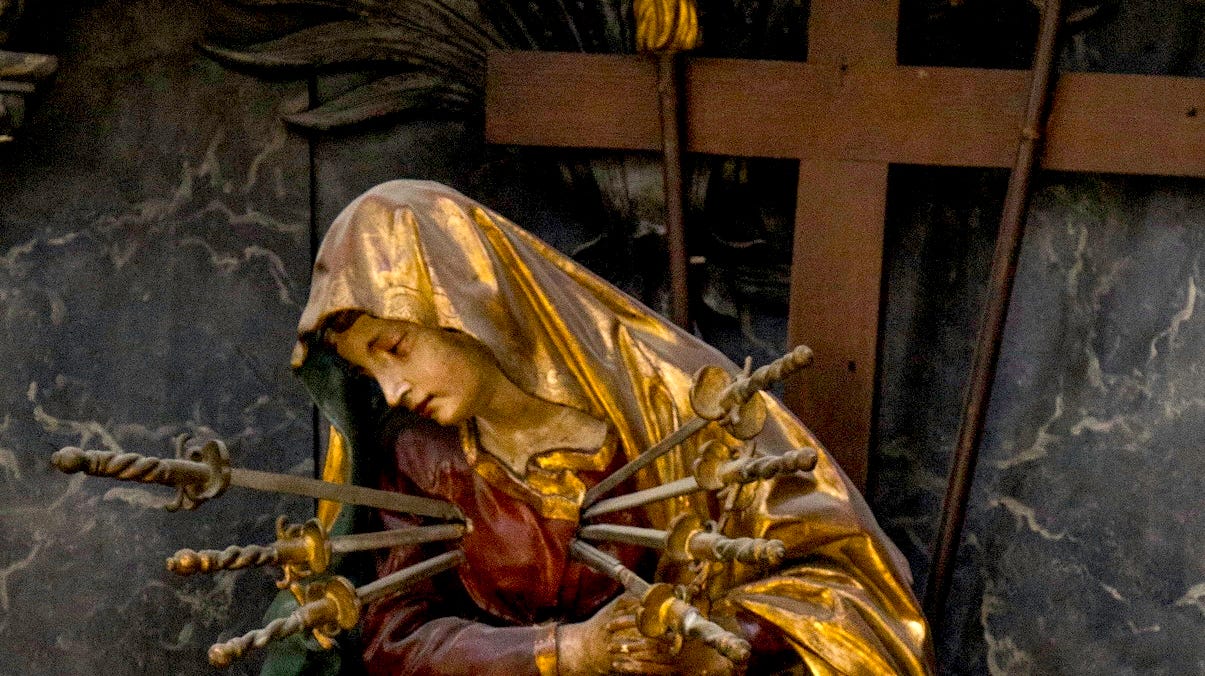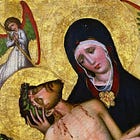How Our Lady consented to and 'co-offered' Christ's sacrifice
The reason we call Our Lady the 'co-redemptrix' goes beyond mere pious enthusiasm.

The reason we call Our Lady the 'co-redemptrix' goes beyond mere pious enthusiasm.
Editor’s Notes
In this part, Fr Coleridge tells us…
How Mary’s suffering on Calvary matched her Son’s Passion in depth and intensity.
That God’s providence required her presence, sharing His pains and consenting to His Sacrifice.
Why her role as the second Eve crowns her co-operation in the mysteries of redemption.
He shows us that Mary’s Compassion was not accidental but divinely ordained, binding her heart to every pang and glory of her Son’s Passion.
‘Co-offering’ Christ’s sacrifice is a bold claim. Pope Benedict XV wrote, in words which echo those of Coleridge:
“For, as she suffered and almost died together with her suffering and dying Son, she gave up her rights as mother over this Son for the salvation of men and, to appease Divine justice, she, as much as it pertained to her [quantum ad se pertinebat], immolated Him, so that it can be said appropriately that she has, together with Christ, redeemed the human race [Ipsam cum Christo humanum genus redemisse].”1
For more on the context of this two-part mini-series, see Part I:
The Compassion of Mary in General
The Mother of the King, Book IV, Chapter III
Burns and Oates, London, 1886
How Mary united both perfect sorrow and peace during the Passion
How Our Lady consented to and 'co-offered' Christ's sacrifice
Poignancy of grief
Recap: It is no exaggeration, that which is said by some of the Fathers, that our Lady’s heart was so perfectly united to the Divine will that, if it had been necessary for its full accomplishment, she would have helped herself in the raising her Son upon the Cross.
For no one but our Lord clung with greater devotion than Mary to that adorable will, no one but He saw in it more perfect beauty, more wonderful wisdom, more infinite compassion and mercy. No one but He saw in the sins which were thus to be wiped away more deadly foulness and more loathsome degradation of the creature made in the image of God and destined for the possession of Him hereafter. No one but He could see the value of the graces which were purchased for mankind by the sufferings of those hours in a more full and piercing light.
To say this is not to say that the Compassion of our Lady was in any way less keen and poignant on this account.
As our Lord suffered to a degree which no one else ever attained in the way of pain, of shame, of weariness, of desolation, and weakness, notwithstanding that His will was so perfectly united to the Divine will, and that He had the most perfect certainty of His ultimate triumph in His Resurrection from the dead, so also our Lady could suffer the intensest pain for Him and with Him, although she had this most perfect conformity to the sentence of the Divine justice and mercy which had decreed it all, her sufferings as well as those of her Son.
Rather, the solemn judicial character of the pains of the Passion sharpened every pang and added weight to every blow. For everything came in the most intense and unbroken severity as the expression of the anger of the Father at the sins with which His Son was clothed in His sight, the sins which He had made His own for the purpose of their expiation, the sins of which in more than one place of Sacred Scripture He speaks of as His.
The anger of God was something sharper than the scourge, bitterer than the vinegar and gall, more hard to bear than the nails and the crown of thorns. If all the pangs of the Passion had been put in one balance, and all the anger of God in the other, the first would have seemed a chalice of delight in comparison to the last. But the two crosses were not, and could not be, separated either in the mind and heart of our Lord or in the mind and heart of His Blessed Mother.
It was not only that He had to suffer so much. It was that He had to suffer so much from the anger of His Father, and on account of sin. St. Paul says “the sting of death is sin,” and it may be said most truly of all our Lord’s Passion that sin was its sting, and the hand which drove it home was the hand of the justice of God.
She was fortified to bear more
Apart from this consideration, it is reasonable to think that our Lady, instead of being in any way or degree rendered less sensitive to the sufferings of her Son or to her own in the Passion, was more probably fortified in a marvellous manner, not against the pain which she had to undergo, but against the natural power of all that pain to take away her life before she had suffered to the utmost, according to the decree of God.
We have seen elsewhere that it might have pleased God to take her away before the Passion, lest she should have that most terrible of sufferings to bear, but that He had in His Providence arranged that her extreme suffering on Calvary should fulfil a part of His purpose in her regard, and in regard to her Son, and be the foundation of another disposition of the same Providence with regard to her position in the Kingdom founded on the Passion. St. Joseph was taken away, but our Lady was not taken away.
It was in the counsels of God that she should be with our Lord in that last scene of agony and torment, that He might have that suffering, also, of her companionship in His sorrows, and that she also might have all the additional grief to bear which came from her witnessing His last agony.
The Divinity of our Lord is thought to have sustained Him miraculously, in order, not that He might have comfort under His sufferings, but that He might suffer more than His Humanity could have borne without special assistance. There may have been something of the same kind about the sorrows of Mary on Calvary, and this is far more likely than that there should have been any preternatural assistance given to prevent her from feeling to the utmost what a mother such as she was would feel on such an occasion.
Under a sentence
It is natural that we should add to this, as has been said, another thought to which it naturally leads, namely, that it was in the Providence of God that Mary should suffer in this way for the accomplishment of a great purpose of God.
She was under a sentence, as her Son was under a sentence. She was to bear now the travail pangs which she had been spared when our Lord came forth at Bethlehem from her most pure and immaculate womb. The Passion was to be communicated to her, as the saints tell us, in a way and with a result which has no parallel in the similar communications which have from time to time been made to some of the chosen servants of God.
Her sufferings could not share in the redeeming efficacy which belonged alone to those of our Lord. But, as she was to have so large a power in His Kingdom in the application of the merits of the Passion, as also so unrivalled and unique a share in the spiritual graces won thereby, it was a part of God’s counsel that she, as the Mother of the Crucified, should share, as far as was possible for her, in the sorrow and in the merit of the Sacrifice of her Son.
Her presence on Calvary was no accident, but a counsel of God. She appears there as she appears in the mystery of the sanctification of St. John Baptist at the Visitation, and in the mystery of the beginning of signs at the marriage-feast of Cana. In all these mysteries Mary is an intelligent and willing cooperator in the Divine work which is being accomplished, as she was the cause, by her fiat, of the accomplishment of the Incarnation itself.
In the Visitation, her words brought about the interior sanctification of the soul of one of the highest of the saints, the soul of whom our Lord said that among those born of women there had not arisen a greater than he. At Cana, her words brought about the opening of the gates of God’s mercy on mankind in the physical miracles of our Lord. On Calvary, she consents, at the cost of infinite pangs of her own, to the Sacrifice on which hangs the redemption of the world, and as she has so large a communication of the pains of that sacrifice, she has also to win thereby her large communication of its powers. It is then that she is crowned as the second Eve, the Mother of all that live.
Her share in the sufferings
When we think, therefore, of Mary at the foot of the Cross, we must consider her as being there by the Providence of God to share in the sufferings of her Son, brought upon her by the infliction on Him of the chastisements due to the sins of the world. We must gather up all our highest conceptions and conclusions as to her intelligence of Him and her love for Him, all that she has learnt of His dignity and His ineffable loveliness, her estimate of Him as God and Man, all that her long study of the beauties of the Sacred Humanity, so freely opened to her, has accumulated in her heart.
Her long and tender familiarity with Him has taught her to anticipate His thoughts, to read His glances, to interpret His gestures. She knows what pains Him and pleases Him, what He shrinks from, what He loves. She knows the delicacy of His purity, the sensitiveness of His charity, the shrinking shyness of His modesty, as well as His fathomless love for souls and His boundless devotion to His Father. And she has, as we think, preternatural sympathies with Him also, which enables her to read the designs, the desires, the hidden pangs and revulsions of the Sacred Heart.
Herself the tenderest heart next to His, with capacities alike of joy and of pain to which our most refined feelings are dull and gross indeed, she is launched on these sixteen or eighteen hours, between the exit from the Cenacle and the expiration on the Cross, to bear in her heart what He bears in His, and in His Body as well. No pang is lost upon her, nor any display of character, nor any example of virtue.
She notes when He speaks as God, as when He cast down the armed band by the simple word, “I am He,” when He speaks as Judge, as when He foretold to the Sanhedrin His coming in the clouds of Heaven, when He speaks as King, as to Pilate and to the thief, when He witnesses to the truth, as before the tribunals whenever He spoke, His use of His power of conversion, as when He looked on Peter, His compassion for the women of Jerusalem, His patient charitable toil for the Roman Governor, His stern silence to Herod, His poignant grief over Judas, His pity for His executioners. Nothing is without its due response in her heart, all is treasured up and pondered there.
Three parts in the Compassion
It may be convenient to divide our consideration of the Compassion of Mary into three parts, according to the stages of the history in which she took part in a different way.
For several hours, how long we know not, it seems likely that she did not witness the actions of our Lord except spiritually. It is not easy to think of her as present in the Garden, or at the apprehension of our Lord, or to suppose that she followed Him into the palace of the High Priest, or through the streets to the Prætorium.
The first part of the Passion, therefore, nearly up to the Scourging, was spent by our Lady in some retired spot near at hand, whence she could be called by St. John when the time came for what it was ordained that she should witness.
After this follow several hours, during which she was either close to or not very far from our Lord, and when she witnessed almost all that passed, except perhaps when He was alone with Pilate. This space of time includes also the final Sentence, the Way of the Cross, and the Crucifixion.
We may make the third part of the Compassion begin when the executions have done their work. The cries and mockings gradually die away, the darkness draws on in which the Three Hours are shrouded. This is the time of the most solemn mysteries, the Seven Words, the vinegar and gall, the breathing forth of the Soul of our Lord into the hands of His Father.
But with our Lord the Passion ends with His Death, with Mary the Compassion lasts on beyond His Death. She has to witness the piercing of His Heart, the Water and Blood, the Birth of the Church. The daylight returns to light up the solemn stillness in which He is taken from the Cross, and laid first in her arms, then in the sepulchre. Then as the shadows of evening thicken around her, she leaves Him there with the stone rolled up and the Roman guard approaching to watch around the Tomb.
Subscribe now to never miss an article:
The Compassion of Mary in General
How Mary united both perfect sorrow and peace during the Passion
How Our Lady consented to and 'co-offered' Christ's sacrifice
See also:
Here’s why you should subscribe to The Father Coleridge Reader and share with others:
Fr Coleridge provides solid explanations of the entirety of the Gospel
His work is full of doctrine and piety, and is highly credible
He gives a clear trajectory of the life of Christ, its drama and all its stages—increasing our appreciation and admiration for the God-Man.
If more Catholics knew about works like Coleridge’s, then other works based on sentimentality and dubious private revelations would be much less attractive.
But sourcing and curating the texts, cleaning up scans, and editing them for online reading is a labour of love, and takes a lot of time.
Will you lend us a hand and hit subscribe?
Follow our projects on Twitter, YouTube and Telegram:
Available at Rorate Caeli, cited in Sacrae Summa Theologiae IIIA.






Very interesting. Do these perceptions of the Blessed Mother come more from the mystics or more from tradition?......Thanks and Blessings!